Here is a strange story involving “knights,” a castle, an explosion, secret societies and lots and lots of helmets. It has the making of a Da Vinci Code setup, but is actually far less exciting – albeit interesting to collectors, history buffs and average curiosity seekers.
The story revolves around Francis Bannerman VI, a Scottish immigrant who started a business in 1865 purchasing surplus military equipment at the close of the American Civil War. Bannerman opened a store on Broadway in New York City and supplied volunteers for the Spanish-American War, and then playing war profiteer on both ends of the conflict bought up surplus Spanish weapons and equipment following the war, along with equipment captured by or sold for surplus by the U.S. government.
Bannerman, who was already publishing a catalog, expanded it to 300 pages. Among the buyers were various “secret societies,” and fraternal organizations, who looked to acquire military-esque uniforms and hats.
In 1900 Francis Bannerman bought Pollepel Island in the Hudson River, north of New York City, to store his arsenal of weapons and ammunition. Bannerman designed the structure himself and it had the look of a European castle.
While much of it was just really a warehouse, a small “castle” was build that served as residence. However, while it served as a giant advertisement for his famous catalog, it wasn’t actually finished by the time of his death in 1918.
Two years later in August of 1920, 200 tons of shells and powder exploded and destroyed the complex, leaving the castle in a semi-ruined state.Tours continued to be given however and the castle was a popular sight along the Hudson River.
A fire in 1969 further destroyed much of the castle, reducing it to a mere shell. The entire island is now off limits to visitors and can only be seen by boat or from the shore.
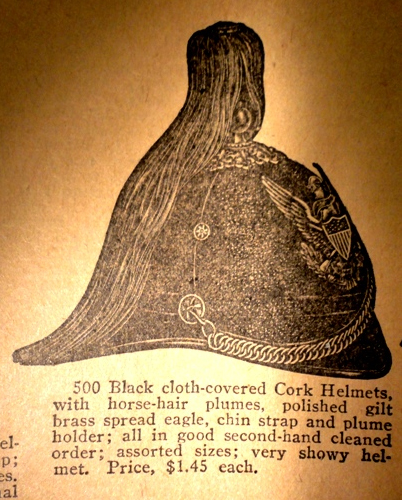
Most collectors are shocked by the prices, but must remember that in 1920 this was still a great deal of money for a helmet!
The catalog however continued to be published, with a shift from firearms (for obvious reasons) to other surplus military goods. Collectors today often marvel at the prices of items – but must remember that inflation very much needs to be considered. You don’t build a castle by giving away stuff!
Publication of the famous catalog finally ceased in the late 1960s after the fire that gutted the castle. And with it an era came to an end.
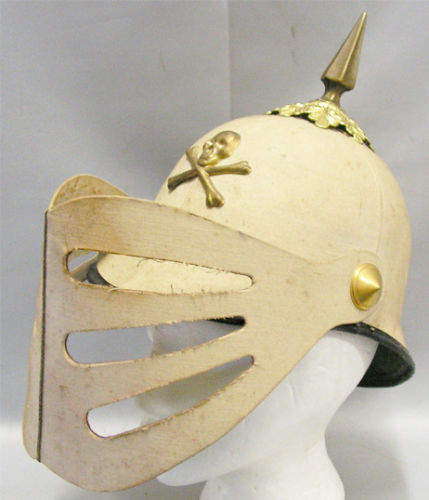
With its helmet spike, crossed bones and skull and side buttons this could be easily confused with a military helmet – but this is actually a ceremonial helmet from the Odd Fellows
Two organizations that likely obtained their unique “helmets” from Bannerman were the Independent Order of Odd Fellows, which was founded in Baltimore, Maryland in 1819; and the Knights of Pythias, which was founded in Washington, D.C. in 1864.
While considered “secret societies” neither was actually all that “secret.” The Odd Fellows is still around today – without the helmets – and has 12,000 lodges and nearly 600,000 members.
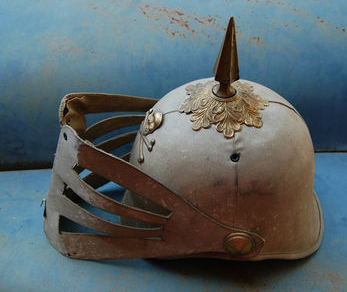
Another Odd Fellow Helmet that shows that the spike could be of military surplus as it is similar to the type used on the dark blue dress helmets
As of 2003 the Knights of Pythias had 50,000 members, and the lodges are reportedly called “castles.”
From the late 1890s to the 1920s both groups used white helmets that were likely based on the American summer sun helmets used by the U.S. Army and various National Guard units. Because of the reduced size of the U.S. Army in the post-Civil War era the helmets were not likely of “military surplus” despite claims from many helmet collectors.
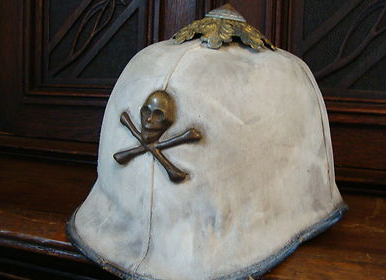
This helmet without the front “visor” of the other Odd Fellow hats does have the appearance of “colonial pattern” sun helmet
The Odd Fellow helmets do tend to feature surplus hardware, including a spike base and spike. Most feature a skull and cross bones and this has lead to confusion with sellers at militaria shows and on eBay suggesting that these are “military” helmets possibly from Germany or used by Dragoons, Lancers or other cavalry units. Instead these are simply lodge hats, and while potentially interesting these are not military surplus.
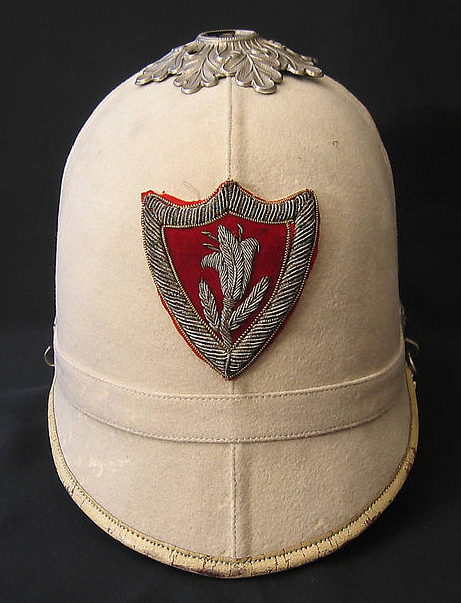
A Knights of Pythias dress helmet. These appear to be well constructed and are often confused with military sun helmets
However, the catalog did sell a great deal of military surplus, including helmets, and this could help explain why so many American white “summer” helmets are so often seen with hardware including helmet plates, spikes, side buttons and chin chains.

The widely produced Model 1887 American sun helmet. Despite rumors that these were British made, these helmets were produced in large numbers by Horstmann Brothers and Company of Philadelphia, a well-known dealer and manufacturer of military uniforms. Many were sold as surplus in the Bannerman catalog apparently unissued
Mark Kasal and Don Moore note in their book A Guide Book to U.S. Army Dress Helmets: 1872-1904 that “At no time were the helmet plate, bands, plume, and plume socket intended by the regulations to be worn on the helmet, and none were prescribed. It can be assumed that a number of officers did add these items.”
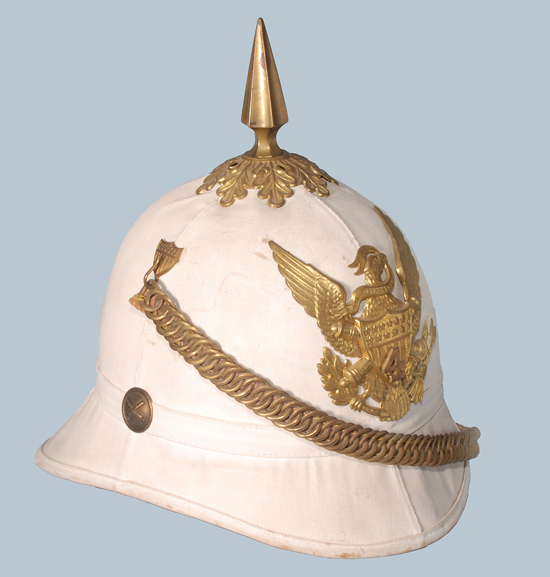
While these white helmets were never officially issued with brass accoutrements, many officers applied their dress spikes and front plates. This practice was officially banned by 1905 when the American army redesigned their uniforms
It can also be assumed that since the helmets, and more importantly the accoutrements were available through various catalogs, including Bannerman’s – that much of this hardware could have been added later. It is also impossible to know whether complete helmets with added hardware were sold, or if the items were added by individuals.
However, given that there are helmets that are mismatched with the wrong side buttons for the plate (i.e. infantry buttons but with artillery plate) these could likely have been done by individuals over time – while the helmets that match with complete hardware could have been done by officers looking to use their white helmets as a summertime dress helmet. Period photos do support the latter case – but again, how widely this practice was done is an unknown.
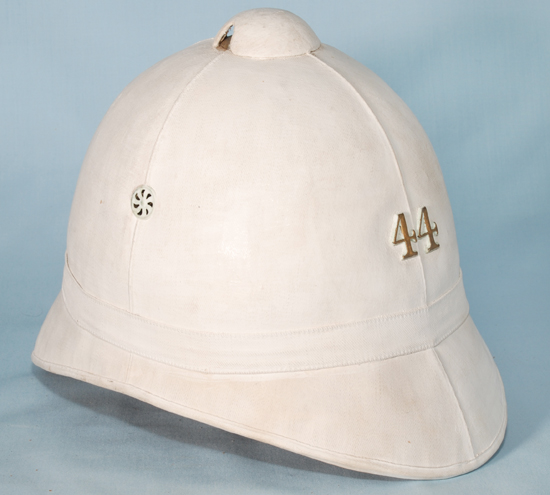
This helmet is the New York National Guard variation made by Ridabock & Company, formerly Baker and McKenney. It is stated that many “Odd Fellow” hats may have been National Guard helmets but a simple comparison shows this is a different helmet pattern
What is absolutely certain is that those other helmets from the fraternal groups feature military hardware on shells that are not military. These often feature full silk linings – often red – whilst the headbands provide no ventilation. In fact many of the lodge helmets/hats lack any ventilation and this is an easy indication that these were never intended to be military sun helmets.

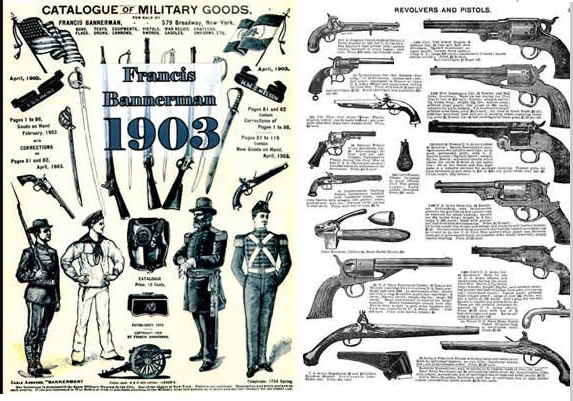
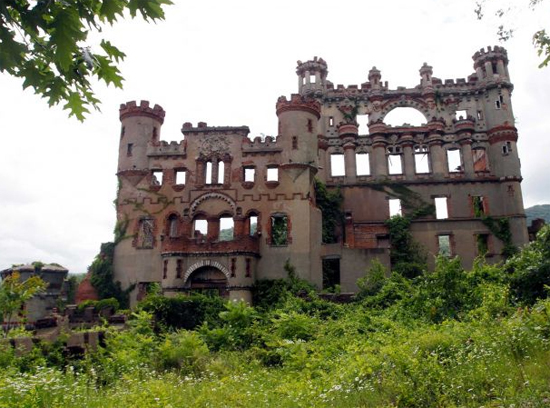
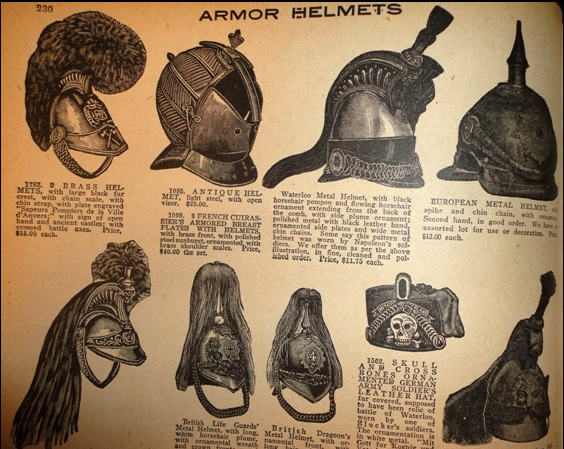
I have a few catalogs from s&s firearms dated in the 1970’s where they were still selling surplus white and tan 1899 pith helmets. They were being “decorated” with 1882 spikes,eagles and buttons and would account for so many being found today. Actually few photos(if any) exist showing these decorated helmets being worn by the regular army when the helmets were in regulation.These helmets remained popular with civilian bands for many years up until around ww1.
I came upon what I’ve been told is a very old Odd Fellows helmet. Any idea how I would find out if that is what it is and what I should do with it? Thanks!
Kerri7868@yahoo.com
kerri7868 at yahoo.com
I would love a catalog.Rick Myers 1150 Ross road new Cumberland wva 26047. Thanks